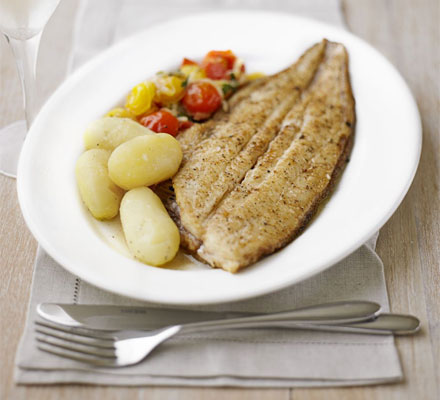Pan-fried Dover sole with warm tomato compote
Simply cooked, so you can really appreciate the flavour of this Rolls-Royce of fish
-
Prep:1 hrs
Cook:30 mins
- Serves 2
- More effort
Nutrition per serving
-
kcal 1053
-
fat 71g
-
saturates 20g
-
carbs 55g
-
sugars 7g
-
fibre 3g
-
protein 53g
-
salt 1.08g
Ingredients
- 3 tbsp olive oil
- 2 shallots, sliced
- pinch caster sugar
- 250g cherry tomatoes, halved - a mix of red and yellow looks good
- 1 tbsp balsamic vinegar, white balsamic vinegar is best
- handful coriander leaves, roughly chopped
- 200g plain flour
- ½ tsp cayenne pepper
- 2 Dover sole (about 350g each, see TIP)
- 5 tbsp sunflower oil
- 50g butter, diced
- half a lemon
- buttered, peeled new potatoes, to serve (see TIP)
Tip
TipIf Dover sole is too expensive or not available, use lemon sole or the smaller sand soles, but don’t take it off the bone before serving as the flesh will be softer and fall apart.Tip
I serve little waxy potatoes such as Ratte, Charlotte or Pink Fir Apple with Dover sole. For maximum flavour, boil them in their skins. After cooking, cool and peel them, then reheat in melted butter mixed with a splash of water.Tip
Dover sole can vary in size. A 300g-400g fish is the perfect portion for one. A much larger one will serve two – as the flesh will be thicker you will need to cook it for a few minutes longer on each side. Ask your fishmonger to remove the dark top skin from the soles.
Method
Make the compote. Heat the oil in a large, non-stick frying pan, then sizzle the shallots for 2 mins until starting to soften. Season with salt, pepper and the sugar. Add the tomatoes, then cook for 2-3 mins over a high heat until they start to release their juice. Drizzle over the vinegar, bubble for a few mins, turn off the heat, then scatter over the coriander. Transfer to a plate.
Now start the fish. With a large chef’s knife, cut off the head just past the gill (you can use this for stock). Using a pair of kitchen scissors, trim away the frills from either side of the fish. Squeeze out any roe from the cavity then pick out and wash away any blood. Pat dry with kitchen paper. You will now have a trimmed slipper-shaped fish ready to be pan-fried.
In a large, shallow dish mix the flour with cayenne pepper and season with salt. Dip each fish in the seasoned flour to completely coat, then pat off the excess. Set the fish aside.
Heat the oil in a large, non-stick frying pan until hot. Place the floured fish in the pan, skinned side down. Shake the pan a little, then cook the fish, undisturbed, for about 4 mins until golden brown.
Using a fish slice, carefully turn the fish over, then continue to cook on the underside for 2-3 mins until it has shrunk and is starting to come away from the bone. Add the pieces of butter to the outside of the pan and let them sizzle into the oil.
Fry the fish for another 2-3 mins, constantly spooning the buttery oil over it to finish the cooking and keep it moist.
Squeeze the lemon half through your fingers over the fish and cook for about 30 secs longer. Remove from the heat, then rest the fish in the pan for 2 mins.
To remove the bones, sit the fish on a board, skinned side up. Run a fine fish slice or filleting knife down the natural line in the centre of the fish. Push the fillets away from bone, but leave them attached to the outside of the fish. Working from the head end of the fish, slowly pull the main skeleton out, easing the fillets aside as the bone comes loose. Carefully push the fillets back to reform so it resembles the whole fish again.
Serve on a large plate with the tomatoes and some buttered new potatoes.





















